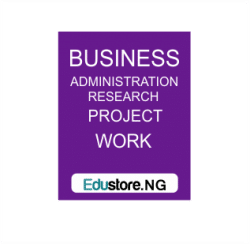Job Supervision And Employee Effectiveness In Manufacturing Sector, Rivers State
ABSTRACT
Although supervision has always been integral to every organization in Nigeria, it has either been ignored or received with little attention in the past years. The study was designed to explore the effect of supervision on employee effectiveness in the Manufacturing sector, Rivers state. It investigated the type, nature, challenges and effects. The study argues that while provision of infrastructure and personnel are vital for ensuring quality employee effectiveness; the absence of supervision could lead to low performance. The study employed the desciptive survey as the research design. The simple random and purposive random sampling were used, to gather and collate first hand information relevant to the study from respondents in order to access the effect of supervision on employee effectiveness. In all 50 respondents including directors, external supervisors, circuit supervisors and other staff (training officers, budget officers and administrators).These respondents provided information relevant to the study. The outcome of the study indicated that while majority of internal supervisors preferred and advocate for greater emphasis on internal supervisors, the external supervisors (from regional office) preferred the promotion of both systems in the Manufacturing sector. It also came to light that supervision cannot be overlooked since it is a major tool for better employee effectiveness giving the right supervisors, right tools and right resources. The study showed that appraisal results are important for counseling sessions since staff expects that they are directed where they fall short. Supervision cannot have effect on performance if staff job satisfaction is down played. For improved performance, supervisors must make staff job satisfaction their top priority.
CHAPTER ONE
INTRODUCTION
1.1. BACKGROUND OF THE STUDY
Supervisors have come under pressure, several times on their effect on employee effectiveness. However, no matter what criticisms are leveled against them, their contributions cannot be over emphasised. If supervisors have the responsibility of improving employee effectiveness by equipping them with knowledge, interpersonal skills, and technical skills then one will say that organisations cannot do without supervisors‟ involvement.
Mills (1997) asserted that supervision has direct effect on employee effectiveness. Supervisors assign task and clear responsibilities of performing those tasks and they in turn expects accuracy and punctuality from assignees. Also supervision gives the right direction to people under supervision to enable them to take initiative and responsibilities to go ahead on their own. Supervision seeks to equip individuals with the necessary knowledge, attitudes and skills to make them useful; not only to themselves but their immediate community and country.
It is important that employee effectiveness are constantly monitored and reviewed for it to be abreast with changes and developments. Today, supervision appears to be sporadic and quite often, serves as a token activity that is unable to achieve the objectives for which it is intended.
Supervision is then seen as a control mechanism which has the task of correcting the activities of individuals and groups to ensure that their performance is in accordance with plans. Plans must be made but in most cases might not be achieved unless activities are monitored, and deviation from plans identified and corrected as soon as they become apparent.
This study is therefore, aimed at finding out whether supervision is helping to support and enhancing individuals to achieve autonomy in performing duties effectively.
The significance of supervision for enhancing the performance of staff in an organisation cannot be ignored in the developmental process of any country. Supervision has been defined in various ways by different authors to suit their audience. Tanner & Tanner (1987) perceive supervision as a vital aspect of organised education. This statement is evident in everyday business. Often, men strive to offer the best supervision to sustain workers‟ interest for increase productivity.
1.2. STATEMENT OF THE PROBLEM
A critical assessment of the attitude of staff towards work for which they have been employed, make one wonder what the state of supervision in the manufacturing sector in Rivers state has been. Some people who need the services from manufacturing sector offices think that performance of staff has not been encouraging due to the fact that they have to spend long hours, if not days, before they are able to receive what they need from those offices. According to Wiles (1967) supervision is an effective tool that could be used to promote good results as far as employee effectiveness is concerned. It is also acknowledged that there is always a link between supervision and effective work, but this will be perfectly true only when the needed resources and commitment are available and are put to judicious use. Though employee effectiveness may not be the only criterion for measuring effectiveness of supervision, it is important that all stake holders of education make it relevant to be used here as a proxy for measuring effectiveness of supervision.
It is generally accepted that structures put in place in every institution must be seen working and to ensure that work is really being done, supervision methods such as monitoring, support and evaluation must come into play. Records of action plans, monitoring and follow up reports show that supervision goes on in every unit, but unfortunately the effect does not seem to show in the work life of staff. Is supervision being carried out well in the Manufactuing industry? Does this appear to affect the performance of its staff? Are there problems or challenges confronting supervision to such an extent that work performance is not the best? These questions have prompted the researcher to find out „The Effect of Supervision on Employee effectiveness in The
Manufacturing sector, Rivers state‟.
1.3. RESEARCH OBJECTIVES
The specific objectives of the research are:
- To identify the nature and practice of supervision in manufacturing sector, Rivers state.
- To examine the challenges faced in the cause of supervision in Manufacturing sector, Rivers state
- To assess the effect of supervision on manufacturing sector, Rivers state.
1.4. RESEARCH QUESTIONS
The following research questions guided this research.
- What is the nature of supervision carried out in manufacturing sector, Rivers state?
- To what extent does supervision have effect on employee effectiveness in the manufacturing sector, Rivers state?
- What challenges do supervisors face in the course of discharging their duties in manufacturing sector, Rivers state?
1.5 RESEARCH HYPOTHESIS
HO1: To examine the challenges faced in the cause of supervision in Manufacturing sector, Rivers state
HO2: To assess the effect of supervision on manufacturing sector, Rivers state.
1.6 SIGNIFICANCE OF THE STUDY
The significance of the study was to investigate into the level of supervisory practices and the competency level of staff. The study also sought to examine the existing level of supervision demonstrated by the four frontline Assistant Directors. Apart from this, the research being the first of its kind in the directorate would go a long way to help to improve upon the supervisory work in order to promote effective and efficient employee effectiveness.
Industrial authorities will also gain insight into the state of supervision under the various units. Such activities will also lead to improvement in employee effectiveness, thereby raising the standard of performance in the municipality.
Finally, the study will add to existing literature on supervision and employee effectiveness for the use of the academic community and the general public. The suggestions that would be made shall hopefully, be found useful in policy decisions that would stress the importance of effective supervision and develop an organisational climate that support positive supervisor-supervisee relationships and allow for frequent and mandatory supervisory sessions.
1.7 SCOPE AND LIMITATION OF THE STUDY
The study focused on staff of Manufacturing sector, Rivers state. The choice of manufacturing sector in Rivers state staff was based on the fact that, they occupy a crucial position in the development of society.
Furthermore, supervision with its accompanying counseling section will make the staff better off to discharge their duties as expected of them.
Given the limitation of finance and time period involved, the study was limited to only Rivers state. Also, only fifty respondents were reached within the region. Not all questions were answered correctly, some questionnaires were also not returned by respondents. Aside this some respondents were also not willing to divulge information. In spite of the anticipated problems, information which was gathered was cross checked to ensure that the quality and authenticity was maintained.
1.8 OPERATIONAL DEFINITION OF TERMS
Supervision: Supervision is the act or function of overseeing something or somebody. A person who performs supervision is a “supervisor”, but does not always have the formal title of supervisor. A person who is getting supervision is the “supervisee”.
Employee: An employee is a term for workers and managers working for a company, organisation or community. These people are the staff of the organization. Generally speaking, any person hired by an employer to do a particular job is an employee.
Employee effectiveness: The degree to which objectives are achieved and the extent to which targeted problems are solved. In contrast to efficiency, effectiveness is determined without reference to costs and, whereas efficiency means “doing the thing right,” effectiveness means “doing the right thing.”
Manufacturing sector: Manufacturing sector refers to those industries which are involved in the manufacturing and processing of items and indulge in either creation of new commodities or in value addition
1.9 ORGANIZATIONAL PROFILE
The study was presented in five chapters. Chapter one discussed the background to the study, the statement of the problem for the research, research objectives, research questions, brief methodology, significance of the study, scope, limitation and organisation of the study. Chapter two looked at the review of literature as it relates to the study. These information were sourced from the internet, documents, both published and unpublished such as books, journals, and newspapers that had useful information on the topic to be reviewed. Chapter three dealt with the methodology which was used in the data collection and how the data was analysed. The sampling technique was also covered. Chapter four constituted data presentation, analysis of results and discussions. Chapter five centered on summary of the study, conclusion, recommendations and suggestions for further research.
DOWNLOAD COMPLETE WORK- For Reference Only: Materials are for research, citation, and idea generation purposes and not for submission as your original final year project work.
- Avoid Plagiarism: Do not copy or submit this content as your own project. Doing so may result in academic consequences.
- Use as a Framework: This complete project research material should guide the development of your own final year project work.
- Academic Access: This platform is designed to reduce the stress of visiting school libraries by providing easy access to research materials.
- Institutional Support: Tertiary institutions encourage the review of previous academic works such as journals and theses.
- Open Education: The site is maintained through paid subscriptions to continue offering open access educational resources.






